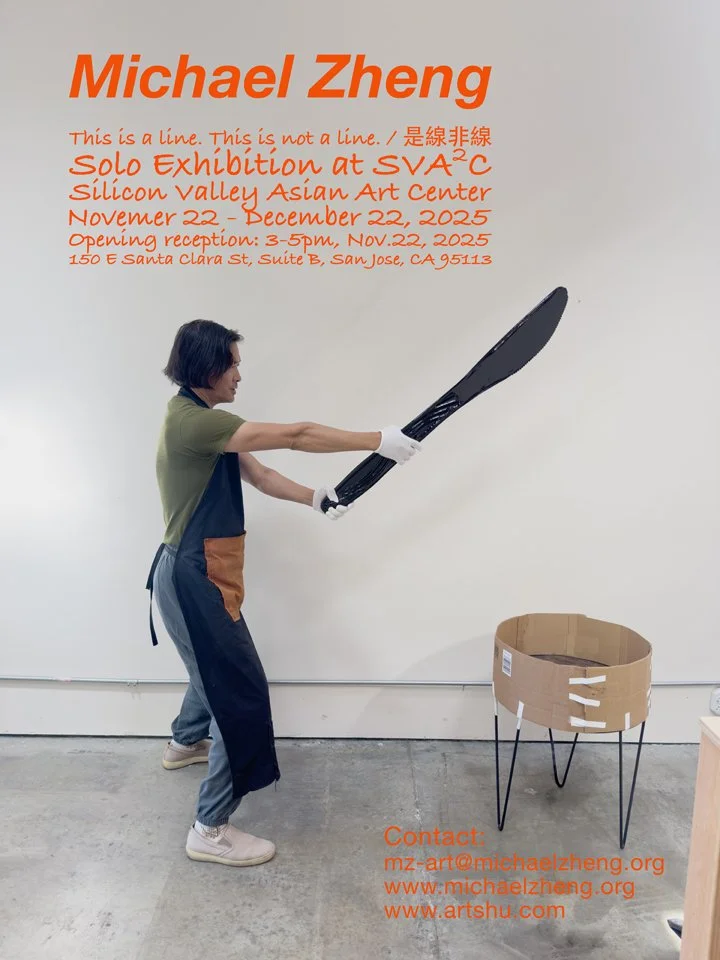Upcoming Solo Exhibition
at Silicon Valley Asian Art Center in San Jose, SVA2C
Exhibition Statement
The title of this exhibition echoes a paradox drawn from The Diamond Sutra, one of the most celebrated scriptures in Buddhism: “This is a line. This is not a line. Therefore it is called a line.” In this simple riddle lies a profound philosophical tension—between what is seen and what is, between naming and knowing. To name something is to enclose it within a concept; yet, as Buddhist and Taoist thought remind us, reality is fluid, indeterminate, and forever slipping past the boundaries of language.
For Michael, an engineer-turned-conceptual-artist, this paradox is not merely an intellectual curiosity but the generative ground of his artistic practice. Born and raised in China, Michael was deeply influenced by Buddhist and Taoist teachings that regard emptiness not as absence but as potentiality. After earning his degree in computer science from Tsinghua University—China’s most prestigious institution—he joined Silicon Valley at the dawn of the Internet age, designing software for the earliest infrastructure of global connectivity, including the first Internet access router. Yet, as technology sought to link the world, Michael began to question the very nature of connection, perception, and reality.
He eventually left his high-tech career to study art at the San Francisco Art Institute on a merit scholarship, working under Paul Kos, one of the founders of the Conceptual Art movement in the Bay Area. During this period, he was selected as a fellow at the renowned artist residencies MacDowell and the Skowhegan School of Painting and Sculpture, where he studied with Xu Bing. These experiences shaped his path toward an art grounded equally in conceptual rigor and spiritual inquiry.
Michael’s work often begins with a simple question: What is it that we see when we see? His art invites viewers to attend to their own perceptual process—to recognize how easily vision, thought, and language conspire to create illusion. Conceptual in nature, his practice spans performance, site-specific installation, and drawing. By reconstituting familiar forms and cultural signs, he reveals the poetic and transcendent dimensions latent in ordinary experience.
The works gathered in This Is a Line. This Is Not a Line. all revolve—literally or metaphorically—around the idea of the line: a mark that both divides and connects, defines and dissolves. Each piece probes the boundary between representation and reality, between seeing and knowing. The installation Wu Wei Landscape unfolds like a spatial meditation on effortless action, while Who Is Afraid of Pixelation? translates digital distortion into tactile form. Life Imitating Art, Genesis, and Line Drawing with Hummingbirds form a conceptual constellation: each autonomous yet derived from the same origin, refracting a shared gesture through multiple perspectives. Only when seen together do their relationships—and their differences—emerge.
Other works complicate this logic of correspondence. This Is a Pipe, This Is Not a Pipe extends Magritte’s famous paradox—“Ceci n’est pas une pipe”—into a physical dilemma: when confronted with an actual pipe, can we still claim it is one? Here, the artist collapses the gap between representation and object, only to reopen it in the viewer’s mind.
Across media—pen drawings, video loops, photographs, and sculptures—Michael constructs situations that subtly disorient our assumptions. In Butterknife Drawings and the accompanying sculpture of a giant plastic knife spreading cream cheese, gesture becomes both absurd and contemplative, transforming a mundane act into an inquiry on perception and process.
Ultimately, this exhibition is less about what a line is than about how it comes to be known. Through his lifelong practice of Ch’an Buddhism, meditation, and yoga, Michael treats art-making as an exercise in awareness: to see not only the world but the act of seeing itself. In the end, each line he draws—whether traced by hand, by a hummingbird’s wing, or by the light of projection—marks the delicate threshold where form arises from formlessness, and where understanding begins to dissolve into wonder.
序言
本次展覽的標題呼應了《金剛經》中的一個悖論:「諸微塵,如來說非微塵,是名微塵。」這句看似燒腦的謎語,實則蘊含著深刻的哲學張力——在「所見」與「所是」、在「命名」與「認知」之間搖擺。命名意味著將某物框定於概念之內;然而,正如佛家與道家思想所揭示的那樣,真實並非固定之物,而是流動的、不確定的,總在語言的邊界之外滑行。
對工程師出身的觀念藝術家鄭濟忠而言,這種悖論並非單純的思想趣味,而是其藝術實踐的根基。他生於中國,成長於佛道思想的滋養之中,這兩種思想皆視「空」為潛能而非虛無。自清華大學獲計算機科學學位後,他在互聯網初興的年代進入硅谷,參與早期網絡基礎設施的設計,包括世界上第一台上網路由器。然而,當科技致力於連結世界時,他卻開始反思連結本身的本質——人如何感知、理解,乃至誤解現實。
後來,他放棄高科技職業,憑優秀獎學金赴舊金山藝術學院學習藝術,師從舊金山觀念藝術運動的創始人之一保羅·科斯(Paul Kos)。其間,他入選麥克道爾(MacDowell)與斯科希根繪畫與雕塑學院(Skowhegan School of Painting and Sculpture)兩大著名藝術家駐地項目,並在斯科希根期間師從徐冰。這些經歷使他的創作路徑兼具觀念的嚴謹與精神的探尋。
鄭濟忠的創作常源於一個簡單卻深邃的問題:「當我們看時,我們究竟看見了什麼?」他的藝術邀請觀眾回望自身的感知過程——意識到視覺、思維與語言是如何輕易合謀,製造出幻象。作為觀念藝術家,他的實踐涵蓋行為、特定場域裝置與繪畫。通過對日常形態與文化符號的重新編排,他揭示出潛藏於平凡生活中的詩性與超越。
此次展出的《是線非線》系列作品,無論在形式上或觀念上,都圍繞「線」的主題展開——那是一種既分界又連結、既定義又消融的存在。每件作品都在再現與現實、感知與認知之間探測邊界。《無為山水》如一場關於「無為」的空間冥想;《誰害怕像素化?》則將數碼失真轉化為具象觸感。《藝術仿效生命》、《創世紀》與《有蜂鳥的繪畫》構成一個觀念星座——各自獨立卻源自同一脈絡,從不同角度折射出相同的動作。只有當它們並置觀看時,其內在關聯與差異才得以顯現。
其他作品進一步拓寬了這一邏輯的維度。《這是一根煙斗,這不是一根煙斗》延伸了馬格利特的名畫命題「這不是一根煙斗」,將語義的悖論轉化為知覺的困境:當觀眾面對一根真實的煙斗時,它仍然「不是」煙斗嗎?藝術家在此將「再現」與「實物」之間的距離壓縮到極致,又在觀眾意識中重新打開。
無論是鋼筆畫、錄像、攝影或雕塑,鄭濟忠的作品都營造出一種輕微的錯位,讓觀眾的假設悄然動搖。在《奶油刀繪畫》及其對應的巨型奶油刀雕塑中,一個看似滑稽的動作被賦予了觀照與反思的意味,將日常行為轉化為對知覺與過程的探索。
歸根結底,《是線非線》並非關於「線是什麼」,而是關於「我們如何認知它」。通過長期的禪修、冥想與瑜伽實踐,鄭濟忠將創作視為覺知的修行——不僅看見世界,也看見「看」的行為本身。最終,他所描繪的每一條線——無論來自手的軌跡、蜂鳥的振翅,還是光影的投射——都標示著一個微妙的閾限:在形與無形之間,在理解與驚奇交匯之處。

